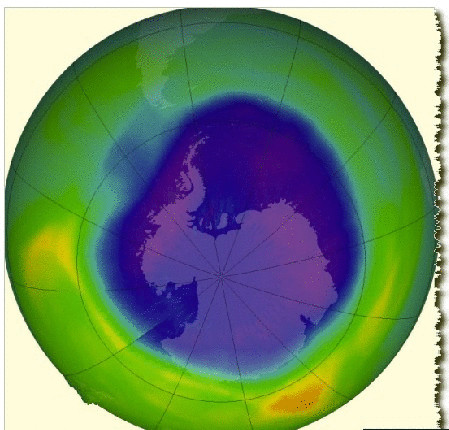The fragile layer of gas that protects all living things on Earth from the sun's harsh ultraviolet light is on the mend—in other words, the ozone hole is healing. That's according to the latest assessment by the World Meteorological Organization and the United Nations Environment Programme.
据世界气象组织及联合国环境规划署的最新评估显示:保护地球上所有生物免受太阳紫外线照射的那层薄薄气体正处于自我修复中——换句话说,臭氧层空洞正日渐变小。
The ozone hole had been growing for decades over Antarctica. But the world recognized the problem and took action more than a quarter-century ago. The 1987 Montreal Protocol phased out the use of chlorofluorocarbons, or CFCs, responsible. With the ozone-damaging compounds gone, the layer had a chance to recover and the hole is no longer growing.
几十年来,南极洲上空的臭氧层空洞在不断扩大。但早在25年前,人们就认识到这一问题,并采取了行动。1987年的蒙特利尔议定书规定:分阶段撤销氯碳化物、氟氯碳化物、以及其他一些会对臭氧层造成破坏的物质的使用。随着破坏臭氧层化合物的减少,臭氧层得以自行修复,臭氧层空洞的数量也不再增加。

the phase-out also helped slow global warming. Because CFCs are also powerful greenhouse gases. In fact, the agreement to address the ozone hole has actually cut five times the greenhouse gas emissions as has the Kyoto Protocol to address global warming.
该分阶段计划也令全球变暖的趋势得以缓解。因为氟氯碳化物是强大的温室气体。事实上,该蒙特利尔议定书(致力于解决臭氧层空洞问题的)与京都协议书(以解决全球变暖为中心的)一拍即合——议定书的实施能使温室气体排放量降低五倍。
The Montreal Protocol shows that the world can come together to deal with global environmental problems. The protocol also illustrates that actions may require decades to yield results. Which drives home the need to address our climate crisis now.
该蒙特利尔议定书表明了:世界各地的人们可以团结起来,共同解决全球环境问题。同时,该协议还表明:有些问题需要花上几十年的时间才能解决。总而言之,我们现在就该好好解决下气候危机问题了。
来源:可可英语 //www.utensil-race.com/broadcast/201409/328680.shtml












